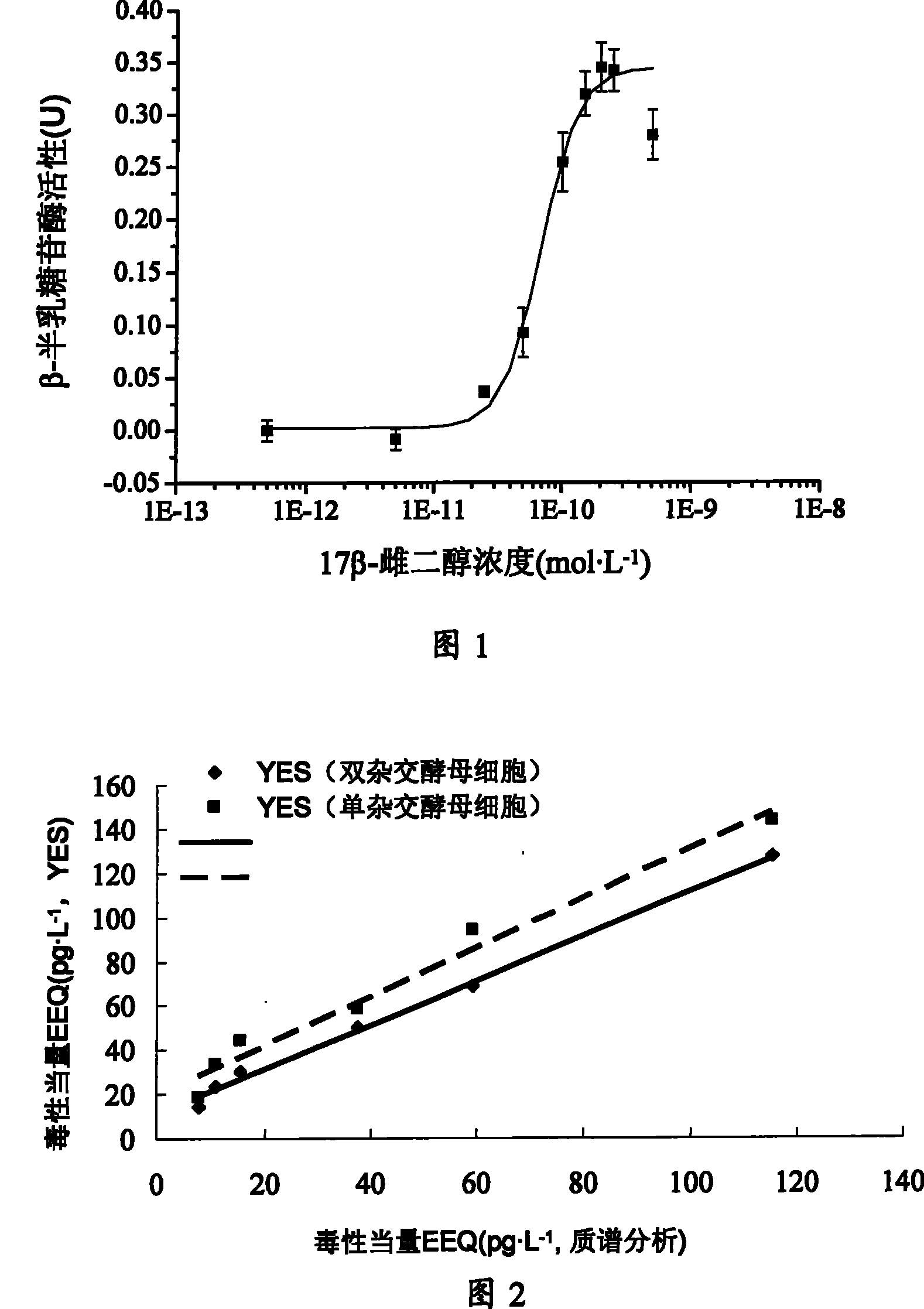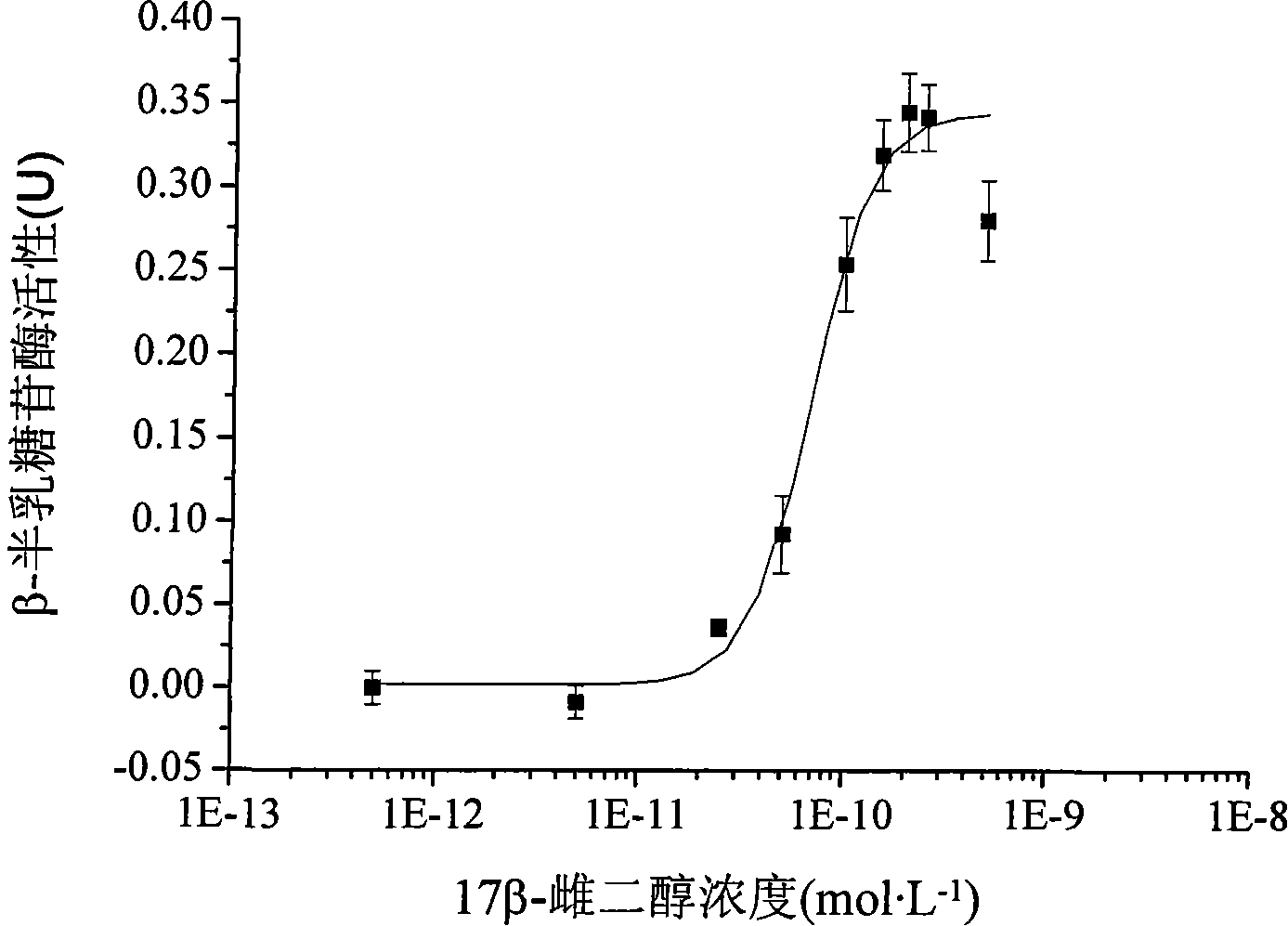Two-hybrid yeast for detecting estrogen-like compound in environment and biological test method
A technology for detecting the environment and estrogen, applied in the direction of microorganism-based methods, biochemical equipment and methods, botany equipment and methods, etc., can solve the problem of lack of receptor co-activation factors, inability to simulate the real situation of eukaryotic cells, and false positives And other issues
- Summary
- Abstract
- Description
- Claims
- Application Information
AI Technical Summary
Problems solved by technology
Method used
Image
Examples
Embodiment 1
[0035] Example 1: Preparation of Saccharomyces cerevisiae ER-GRIP1 (CGMCC No. 2307) cells
[0036] 1. Construction of the pGBKT7-hER yeast expression plasmid containing the estrogen receptor gene fragment (ie the sequence shown in SEQ ID No. 1).
[0037] First, design PCR primers for the estrogen receptor ligand binding domain (hER LBD), and introduce EcoRI and BamHI single restriction sites at the 5'ends of the upstream and downstream primers, namely the upstream primer P1: 5'-TCGCCG GAATTC GCTGGAGACATGAGA-3' (the underlined part is the restriction site of EcoRI); downstream primer P2: 5'-TAACGC GGATCC TCAGACTGTGGCAGG-3' (the underlined part is the restriction site of BamHI); 2.5ng of pASV3 plasmid containing hER LBD (sequence shown in SEQ ID No.1) (gifted by Professor Heery of Nottingham University, UK) 2.5ng was used as a template for PCR amplification The PCR product (0.3pmol) was ligated to the T-vector with T4 DNA ligase (1μL) to construct the T-hER LBD plasmid; pGBKT7 (1μg,...
Embodiment 2
[0044] Example 2: Using two-hybrid Saccharomyces cerevisiae ER-GRIP1 (CGMCC No. 2307) to determine 17β-estradiol (E 2 ) To draw the standard curve.
[0045] Yeast cell culture: inoculate the prepared two-hybrid Saccharomyces cerevisiae ER-GRIP1 (CGMCCNo. 2307) cells into SD / -Trp / -Leu liquid medium (the composition is the same as that in Example 1), and detect the bacteria at 600nm The absorbance value (using the culture medium as the blank), adjust the absorbance value to 0.1-0.2, and adjust the absorbance value at 600nm of the bacterial solution to 0.7-0.8 after culturing in an air bath shaker at 30°C for 24 hours.
[0046] Draw a standard curve: take 0.995 mL of bacterial suspension into the corresponding Eppendorf tube, and add 5 μL of DMSO (blank) or 5 μL of E dissolved in DMSO 2 ; Transfer 200μL of each of the above solutions to a 96-well plate in turn. Then at 130 rpm, 30 ℃ in a 96-well shaker shake culture for 2h; after the end of the culture, first detect the absorbance val...
Embodiment 3
[0050] Example 3: The two-hybrid Saccharomyces cerevisiae ER-GRIP1 (CGMCC No. 2307) biological test method is used to evaluate the toxicity of estrogen-like pollutants in environmental samples.
[0051] The influent and effluent of different water plants in a certain city were collected as samples. Using solid phase extraction method, adding dichloromethane and n-hexane to extract estrogen-like pollutants in the sample, drying the extracted organic solvent in high-purity nitrogen, adding DMSO to dissolve and preparing to be within the linear range of the standard curve Any concentration of test sample solution.
[0052] The two-hybrid Saccharomyces cerevisiae ER-GRIP1 (CGMCC No. 2307) biological test method described in Example 1 was used to evaluate the toxicity of environmental samples of estrogen-like pollutants, and the measurement results were compared with the one-hybrid recombinant estrogen receptor gene yeast method and mass spectrometry The measurement results of the anal...
PUM
 Login to View More
Login to View More Abstract
Description
Claims
Application Information
 Login to View More
Login to View More - R&D
- Intellectual Property
- Life Sciences
- Materials
- Tech Scout
- Unparalleled Data Quality
- Higher Quality Content
- 60% Fewer Hallucinations
Browse by: Latest US Patents, China's latest patents, Technical Efficacy Thesaurus, Application Domain, Technology Topic, Popular Technical Reports.
© 2025 PatSnap. All rights reserved.Legal|Privacy policy|Modern Slavery Act Transparency Statement|Sitemap|About US| Contact US: help@patsnap.com


